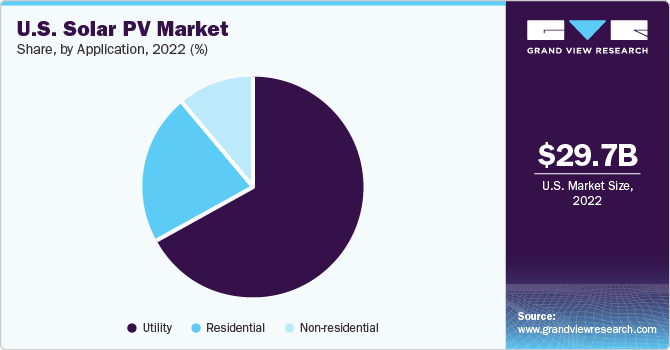U.S. Solar PV Market Analysis: Understanding Consumer Preferences
The U.S. solar PV market was valued at USD 29.68 billion in 2022 and is projected to reach USD 96.6 billion by 2030.
U.S. Solar Photovoltaic (PV) Market Overview
The U.S. solar PV market was valued at USD 29.68 billion in 2022 and is projected to reach USD 96.6 billion by 2030, growing at a CAGR of 13.7% from 2023 to 2030. The market’s rapid expansion is being driven by favorable state and federal policies, incentive programs, and a consistent decline in solar panel costs. These factors have significantly accelerated the adoption of solar PV systems across the country.
The U.S. has seen a notable rise in installed solar power capacity in recent years, primarily due to growing concerns about environmental sustainability and the urgent need to mitigate greenhouse gas emissions. These factors have spurred growth, particularly in the utility sector, as utility-scale solar installations have become more prominent.

Supportive regulatory frameworks and heightened interest from private sector investors are also major contributors to market growth. As emission regulations tighten, the transition from traditional fossil fuel-based power generation to renewable sources like solar is becoming more pronounced. This shift is reshaping the overall power generation landscape in the U.S., favoring clean energy over coal and gas.
The increasing volatility in fossil fuel prices has further prompted investments in solar and other renewable energy sources to stabilize long-term electricity costs. Solar energy is not only more sustainable but has also become more cost-effective—with new solar installations now often cheaper than traditional coal or gas plants. States like California and Texas have played pivotal roles by offering robust incentives and tax benefits to promote solar adoption. For example, California alone has invested USD 80.8 billion in solar energy over the past decade, implementing various programs to encourage residential solar installations.
Order a free sample PDF of the U.S. Solar PV Market Intelligence Study, published by Grand View Research.
Key Market Trends & Insights
- By application, the utility segment held the largest revenue share at 66.68% in 2022. Increasing consumer preference for environmentally responsible energy sources is a key driver, alongside efforts to lower carbon emissions and support sustainable energy infrastructure.
- The residential segment is projected to grow at the fastest CAGR of 13.9% during the forecast period. Rising adoption of solar PV at the residential level, backed by favorable government incentives, is driving growth in this segment from 2023 to 2030.
- The commercial segment is expected to grow at a stable pace. With rising grid energy costs, many commercial entities are opting to reduce dependency on external power by installing in-house solar PV systems.
Market Size & Forecast
- 2022 Market Size: USD 29.68 Billion
- 2030 Projected Market Size: USD 96.6 Billion
- CAGR (2023-2030): 13.7%
Key Companies & Market Share Insights
Leading players in the U.S. solar PV market are focusing on technological innovation and cost reduction to enhance their competitiveness. Many are also adopting strategic initiatives to expand their presence in the renewable energy landscape.
For instance, in April 2022, Primenergy announced the construction of the largest solar PV plant in the U.S., located in Nevada, with a projected capacity of 690 MW. The facility was expected to be operational by 2023 and reflects the growing momentum toward large-scale solar deployment in the country.
Key Players
- First Solar
- SunPower
- Suniva
- 1Soltech
- Sharp
- Alps Technology
- Advance power
- Auxin solar
- BORG Inc.
- Pionis Energy
Explore Horizon Databook – The world's most expansive market intelligence platform developed by Grand View Research.
Conclusion
The U.S. solar PV market is undergoing robust growth, underpinned by a favorable regulatory environment, consistent cost reductions, and a nationwide shift toward clean energy. With support from federal and state incentive programs and increasing awareness of environmental impacts, both utility-scale and residential solar installations are gaining significant traction. The volatility of fossil fuel markets and the rising costs of traditional energy sources are further accelerating the transition to solar power. As technology continues to improve and costs decline, solar PV is expected to play a critical role in the U.S. energy mix, contributing to national decarbonization goals and energy security through 2030 and beyond.